What can I learn from the Highland and Island Emigration Society's passenger lists?
How to search the Highland and Island Emigration Society's passenger lists
Understanding the content of Highland and Island Emigration Society's passenger lists
Background information
The Highland and Island Emigration Society was a voluntary organisation set up in 1852 by private subscription with the aim of alleviating destitution in the Highlands by promoting and assisting emigration. Between 1852 and 1857, the Society assisted 4919 men, women and children to leave western Scotland for Australia. Their details were recorded in the Society's passenger lists. These lists are one of the few sources for emigration held by the National Records of Scotland (NRS reference, HD4/5).
The Society laid down specific criteria for assistance with emigration in their 'Rules of the Society'. Preference was given to assisting entire families over single men, couples and small families. Landlords were expected to contribute towards the payment disbursed by the Society for the emigrants' passage to Australia. The emigrants were subsequently required to repay the Society the funds they had been granted so the sum could be re-invested to help further emigrants.
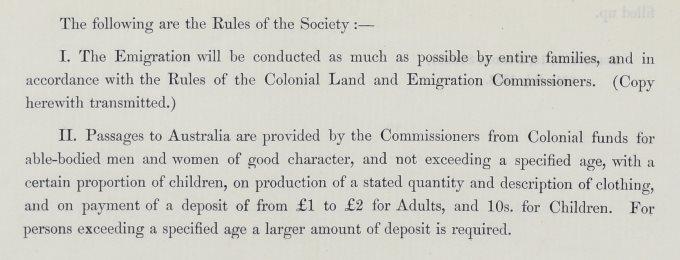
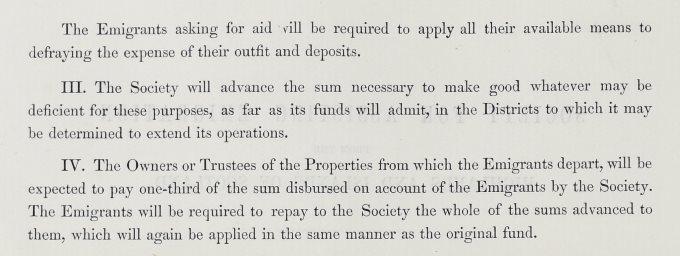
'Regulations Issued By Her Majesty's Colonial Land and Emigration Commissioners' also stipulated specific moral and physical requirements in their 'Qualifications of Emigrants'.
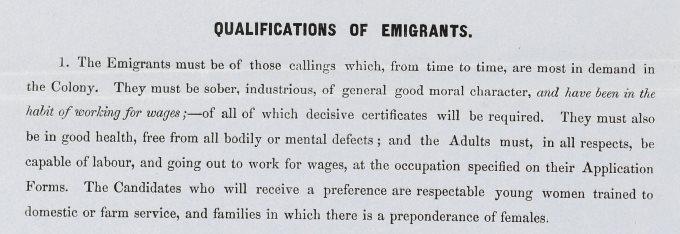
Skye was selected for the Society's first operations owing to the impoverished conditions on the island and in 1852 2569 people emigrated to Australia on twelve ships. Australia was chosen as the destination for the emigrants as it was felt that the Highlanders' experience as shepherds and cattle drovers was well suited for the Australian colonies.
The scheme was then extended to other islands and the western mainland, though there were fewer passengers in later years. In 1857, the last year of the scheme, there were 201 passengers onboard the Persian, which sailed from Liverpool to Hobart Town on 25 July.
During the five years of the scheme, 4919 people were supported by the Society to emigrate to Australia. In 1858 the Society was dissolved and the remaining funds transferred to the Board of Supervision for the new Poor Law of Scotland.
What can I learn from the Highland and Island Emigration Society's passenger lists?
The passenger lists record the surname, forename, age, residence and estate of individuals whose emigration to Australia was assisted by the Society. The records were arranged by ship name, departure port and date and arrival port. Individuals were generally listed as part of family groups, sometimes with notes on their health, appearance and situation.
Norman McSween, a widower, and his children who lived in Bernisdale, Snizort parish, on Skeabost estate, Skye, sailed on the Ontario from Liverpool for Sydney on 3 August 1852. They are described as 'a very poor and destitute family' in the passenger lists.

Two months later, Mary Cumming, a widow, and her daughters, also from the same parish in Skeabost estate on Syke as the McSweens, sailed on the Priscilla from Liverpool to Victoria on 13 October 1852. Mary is described as a 'strong healthy woman. Nurse and Midwife'.

How did the emigrants travel?
The emigrants assisted by the Society travelled on passenger ships. The size of the groups varied: the largest comprised of 758 passengers who sailed from Campbeltown to Victoria in south-eastern Australia, while the smallest group comprised of just four passengers who sailed from Liverpool to Melbourne, Victoria.
The passengers travelled on 26 different ships (on 31 sailings). The majority of them sailed from the port of Liverpool (approximately 3605 on 28 different sailings), and smaller numbers sailed from Campbeltown (758 on one ship), Glasgow (372) and Plymouth (184). The most common arrival ports were Portland Bay, off the coast of Victoria (1208); Victoria (781); and Geelong, Victoria's second biggest city (503).
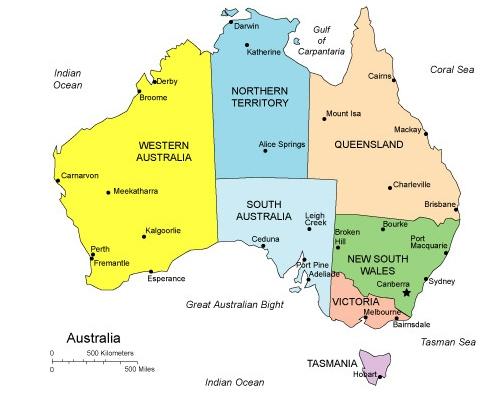
Ship sailings
The passenger lists record the ships' names, departure and arrival ports, departure dates and the number of passengers. Arrival dates are not given. The following is a list of the ship sailings, which included the Highland and Island Emigration Society passengers, from the United Kingdom from 26 January 1852 to 25 July 1857, inclusive (there are no sailings recorded for 1856).
Mangerton, Liverpool to Melbourne, Victoria, 26 January 1852, 10 passengers
Borneuf, Liverpool to Geelong, Victoria, 26 May 1852, 20 passengers
Araminta, Liverpool to Geelong, Victoria, 20 June 1852, 191 passengers
Medina, Liverpool to South Australia, 25 June 1852, five passengers
Georgiana, Glasgow to Port Philip, Victoria, 13 July 1852, 372 passengers
Ontario, Liverpool to Sydney, New South Wales, 3 August 1852, 306 passengers
Ticonderoga, Liverpool to Port Phillip, Victoria, 4 August 1852, 44 passengers
Marmion, Liverpool to Moreton Bay, Queensland, 28 August 1852, 215 passengers
Allison, Liverpool to Melbourne and Victoria, 13 September 1852, 292 passengers
Priscilla, Liverpool to Victoria, 13 October 1852, 298 passengers
Arabian, Liverpool to Victoria, 27 October 1852, 54 passengers
Thames, Liverpool to Melbourne, Victoria, 3 November 1852, four passengers
Hercules, Campbeltown to Victoria, 26 December 1852, 758 passengers
British Queen, Liverpool to Victoria, 8 January 1853, ten passengers
Panama, Liverpool to Van Diemens Land (Tasmania), 8 January 1853, 37 passengers
Bloomer, Liverpool to Sydney, New South Wales, 29 March 1853, 15 passengers
New Zealander, Liverpool to Portland Bay, Victoria, 23 August 1853, 359 passengers
Sir Allan Mcnab, Liverpool to Hobart Town, Tasmania, 28 October 1853, 150 passengers
Utopia, Liverpool to Portland Bay, Victoria, 3 November 1853, 102 passengers
Derry Castle, Liverpool to Portland Bay, Victoria, 1 January 1854, 41 passengers
Arabian, Liverpool to Portland Bay, Victoria, 3 January 1854, 36 passengers
Arabian, Liverpool to Portland Bay, Victoria, 3 June 1854, 213 passengers
Edward Johnstone, Liverpool to Portland Bay, Victoria, 17 June 1854, 356 passengers
Hornet, Liverpool to Geelong, Victoria, 29 July 1854, 292 passengers
James Fernie, Liverpool to Adelaide, South Australia, 18 August 1854, 93 passengers
Derry Castle, Liverpool to Portland Bay, Victoria, 1 October 1854, 101 passengers
Switzerland, Liverpool to Adelaide, South Australia,16 June 1855, 160 passengers
Royal Albert, Plymouth to Adelaide, South Australia, 15 August 1855, 184 passengers
Persian, Liverpool to Hobart Town, Tasmania, 25 July 1857, 201 passengers
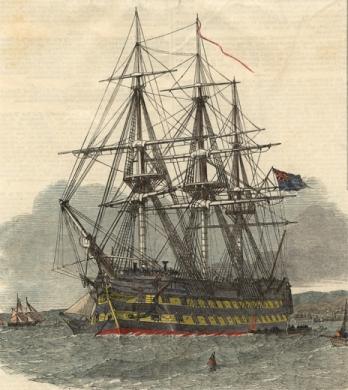
Credit: Illustrated London News, 15 January 1853. Public Domain: https://en.wikipedia.org/wiki/File:HMS_Hercules_leaving_the_harbour_of_Campbeltown.jpg
How to search the Highland and Island Emigration Society's passenger lists
Search the Highland and Island Emigration Society's passenger lists. You can search on some or all of the following index fields:
The search form includes tips for each field with links to more detailed research guides where appropriate.
- Surname
- Forename
- Ship Name (a drop-down list of all ships that sailed under the Society's emigration scheme.)
- Departure Port (results can be filtered by departure port after the initial search)
- Arrival Port (a drop-down list of all arrival ports in Australia.)
- Residence/Estate
- Age/Year of birth
- County/City
- Parish (results can be filtered by parish after the initial search.)
Understanding the content of the Highland and Island Emigration Society's passenger lists
As with any historical record, the spelling of names and place names varies throughout the passenger lists and these have been indexed as they are written in the original source. We have tried to correlate places of residence with their respective parishes and counties for the date that the passenger lists were compiled. However, we cannot guarantee complete accuracy owing to the nature of the original handwriting and spelling. In the late nineteenth century, many parish and county boundaries were changed but those listed in the index were correct at the time the original source was compiled. We have listed the main possibilities where there is some dispute over the correct parish and/or county.
Tracing individual passengers
We have attempted to find individuals listed in the Society's passenger lists in the 1851 Census. This was found to be possible in about 60% of cases, but variant surnames were a common issue. Furthermore, in order to qualify for the emigration scheme, emigrants did not always give their correct ages.
Norman McSween, two sons and one daughter are recorded in the 1851 Census living in Bernisdale, Snizort parish, on Skye. Norman's two other daughters, who are listed as passengers with the family on the Ontario on 3 August 1852, are not recorded in the Census. It is possible that they may have been working away on the night of the Census.

Further reading
The Scottish Archive Network has a useful guide on emigration, which includes further contextual information relevant to the passenger lists alongside an earlier version of the index.
For further information and additional sources on this topic, see the guide on emigration and immigration and the NRS guide for useful websites on emigration.
You may find the handwriting in the passenger lists difficult to read. Look at the guides on reading older handwriting, unfamiliar words and phrases, and search the glossary for assistance with abbreviations, legal terminology, occupations and other unfamiliar words.
Please note that other passengers sailed on the ships used by the assisted emigrants and are not included in the Society's passenger lists. Responsibility for emigration in the nineteenth century lay with the Colonial Office, based in London. Its records are held by The National Archives in London.